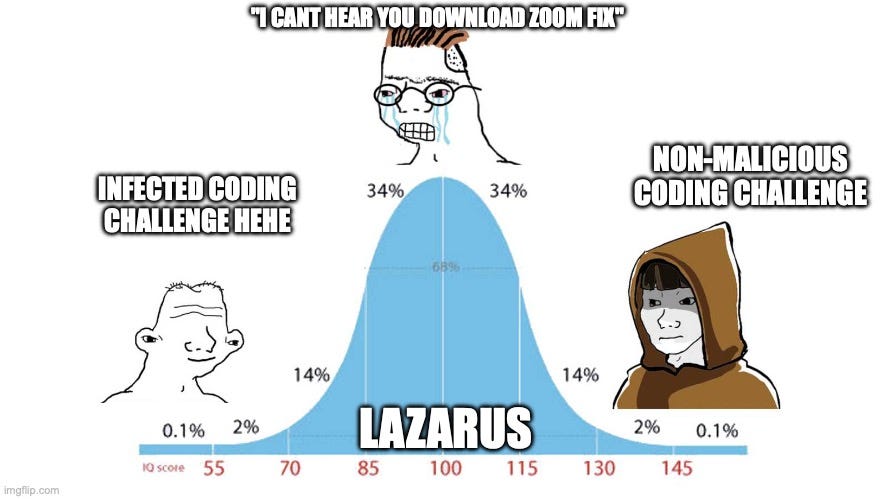Interview with the Chollima
Lazarus tried to trick us... And we ended up stealing their malware
February came and went once again, this time without a peep from our dear friends behind the Great Firewall, nor from those under the menacing guise of the Great Leader. Not that I missed them, but something felt… off.
Had they forgotten about us? Are we no longer that important of a target? Did they simply decide to move on and forgive us every time we mocked them publicly—when their ACME-branded malware blew up in their faces, giving us the chance to weaponize it into talks and articles at the best conferences and magazines in the world?
No, I don’t think they’re the type to turn the other cheek. They waited until April to fine-tune the stockade after planning something highly targeted. At us.
Well, at me.
The North Korean Job
It all started in the most vicious hunting ground for Threat Actors, when a muppet well-respected Lazarus agent approached me carelessly under the name "Wilton Santos", asking if I was open to working on a fix for its DApp.
I asked for further clarification, and the sad story rolled in: they were a team of seven developers, but all of them were on vacation (bad human resources planning there), and needed a trivial but urgent fix on its UI.
The DApp was “Gamba v2”, a gaming platform where users could join by connecting with their wallets (you might think this is the strike point, but that would be too obvious). The UI problem was that they wanted to dynamically display the user’s wallet in a specific profile button. This is pretty trivial, and many JS libraries can do it in two or three lines of code.
After successfully patching the issue, I just needed to send a video of the fix working, and I would be paid the astronomical amount of 500 USDT for a 3-line patch.
<sarcasm>I can’t believe there are BSD kernel developers out there submitting patches for free…
</sarcasm>I accepted, because I can smell a good old-fashioned APT campaign miles away.
And then, our friend “Wilton” shared a BitBucket repository.
Time to get the work done, I guess.
Trying to Catch an Otter
There’s an important context to add here. The Chollimas (North Korean state-sponsored actors) are running a campaign targeting engineers and executives in the fintech and crypto sectors.
They attempt to trick engineers with fake job interviews or postings, coaxing them into running infected coding challenges.
They also target executives by luring them into Zoom calls with fake VCs or business partners. Once in, the attackers feign not hearing the victim speaking and act angry about it. Then, one of them shares a fake Zoom fix or update to solve the issue. Over the fear of the deal going sour, the victim usually runs it and gets infected. This effort is being tracked as DevPopper or ContagiousInterview.
But this time, it’s different. As noted in the closure of the last section, this repository was created just a day ago, with no public mentions of it, the person who shared it with me, or the endpoints and infrastructure it attempts to reach.
Everything is brand new.
But there’s still something more sinister about it: the code is completely clean. There’s no malicious payload, fake packages, infected libraries, or dependencies.
In Gibson’s words: It’s clear as ethanol.
But then, after carefully reviewing the code, I found their entry point, and I must say, it is the most creative one I’ve seen in a long time. While the code itself isn’t malicious, there’s a specific bootstrap function that will always fail. However, it’s contained within a Try/Catch block—a special construct where the language will Try to do something and Catch the workflow if something goes wrong, preventing it from crashing, and doing something to remediate the error.
That Catch block, in this case, will invoke a function called errorHandler, which will receive an error code directly from an external API… and execute it.
You read it right: the error code comes from a distant server in Finland (not a Gibson reference), and it is then executed via a require statement.
This is our implant!
Now, we could just burn it in an intelligence pulse… or better yet, use what we know to strike back.
The server has two open ports: port 80, running the API on Node.js Express, and port 7777, identified as running RDP (Remote Desktop Protocol for Windows).
Reaching out to the API and triggering a fabricated error reveals an interesting internal output, where we can see that our friends are indeed using Windows… with the Administrator user.
Running internet-facing services as a privileged user—worse yet, as Administrator—is a bad idea and Wilton will find out about it pretty soon.
The other service running on port 7777 is Remote Desktop Protocol, which allows us to authenticate—if only we had the necessary credentials.
But that’s a story for another day. They don’t know we know, so let’s use that to our tactical advantage.
Using ANY.RUN’s sandbox, we spin up a disposable Ubuntu machine, install NodeJs, and run the code as if we were an unsuspecting victim trying to make a quick 500 USDT (remember we’re here for that reason after all?).
Running the code, of course, triggers the mandatory failure, which bumps into the Try/Catch block, which receives the error from the Finnish API.
But what does that error say? It’s an obfuscated JavaScript snippet.
This would be executed directly on our local machine while we’re distracted trying to submit a patch for a visual bug. Lazarus loves obfuscating JavaScript code with a popular online tool, but since they don’t know we know, we’ll use it against them.
At first glance, it looks like BeaverTail—one of Lazarus’ latest cyberweapons, commonly paired with InvisibleFerret—but on closer inspection, it turns out to be another animal we still didn’t have in our personal collection: OtterCookie.
This not-so-playful otter works as a Stealer-type malware, targeting browser password managers and extensions (specifically crypto wallets), and is also deployed in the ContagiousInterview campaign.
We tried catching the Otter, and we did. We have the infrastructure, the sample, the involved accounts, and their communication script.
It was time to contact our ‘employer’ to update them on the progress of the job.
Interview with the Chollima
I went back to LinkedIn and told my employer that I had two ways of implementing the patch and would like to have a short meeting to discuss them. He bought it and wanted me to run the sample during the call to see the results.
And so, I started recording my screen, waiting in silence for the wild Chollima to set foot in the trap—and it did, with an anime profile picture and under the name of “0xdori DFO”.
I expected to see a majestic winged horse stomping bravely over the scene, but instead, I ended up with a scared little pony fleeing.
But, I’ll let you judge that for yourself…
The following video has been edited (and the Threat Actor muted) to avoid disclosing certain indicators.
We may upload a full version in the future.
The pony pranced away in panic, without saying another word.
Being gentlemen, I thought we could at least exchange a proper farewell, but I was promptly blocked.
We claimed the game and called it a day.
But, my friends, the hunting season never ends…
Indicators of Compromise
IPv4:135.181.123.177
Domain:chainlink-api-v3.cloud
URL:http[:]//chainlink-api-v3[.]cloud/api/service/token/56e15ef3b5e5f169fc063f8d3e88288e
URL:http[:]//chainlink-api-v3[.]cloud/api/
URL:https[:]//bitbucket.org/0xhpenvynb/mvp_gamba/downloads/
SHA256:aa0d64c39680027d56a32ffd4ceb7870b05bdd497a3a7c902f23639cb3b43ba1
SHA256:071aff6941dc388516d8ca0215b757f9bee7584dea6c27c4c6993da192df1ab9
SHA256:486f305bdd09a3ef6636e92c6a9e01689b8fa977ed7ffb898453c43d47b5386d
SHA256:ec234419fc512baded05f7b29fefbf12f898a505f62c43d3481aed90fef33687
FileName:0xhpenvynb-mvp_gamba-6b10f2e9dd85.zip
SOLWallet:V2grJiwjs25iJYqumbHyKo5MTK7SFqZSdmoRaj8QWb9Resources & References
Acknowledgements & Contributors
This work would not be possible without the contribution from dedicated Lazarus Agents who surrendered their cyber-weapons to the Quetzal Team. We honor them here:
❌ Edward from Labyrinth Chollima. Fell during the QRLog campaign, in which we discovered the QRLog malware.
❌ Nargis from Velvet Chollima. Fell during the DreamJob campaign, in which we captured the Docks malware.
❌ Artyom from Velvet Chollima. Fell during the ContagiousInterview campaign, in which -alongside another team- we discovered the ChaoticCapybara malware.
❌ Wilton from Famous Chollima. Fell during the ContagiousInterview campaign, in which we captured the OtterCookie malware.
Comment [F] to pay respects and don’t cry for them: they fell bravely against the best.



















